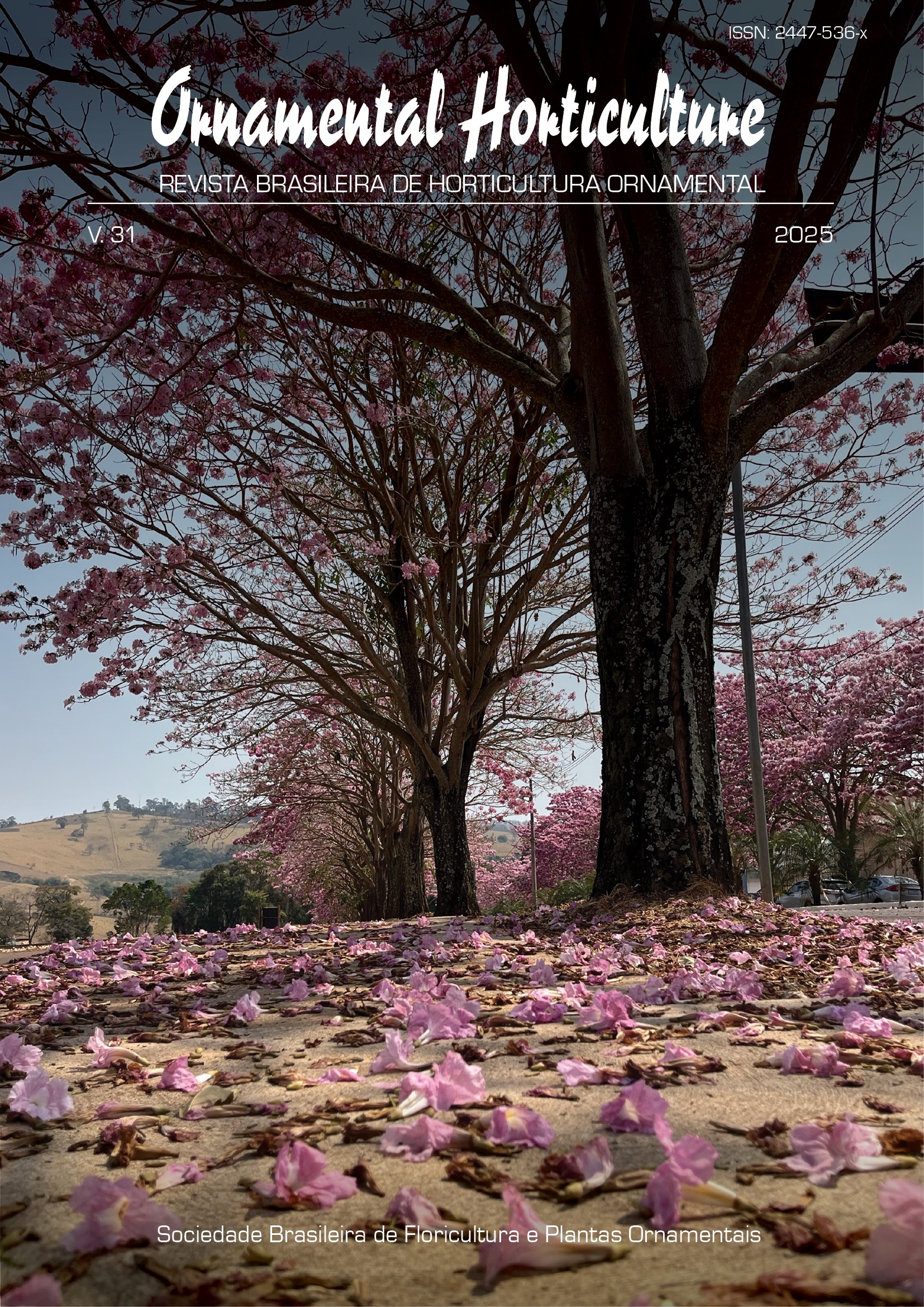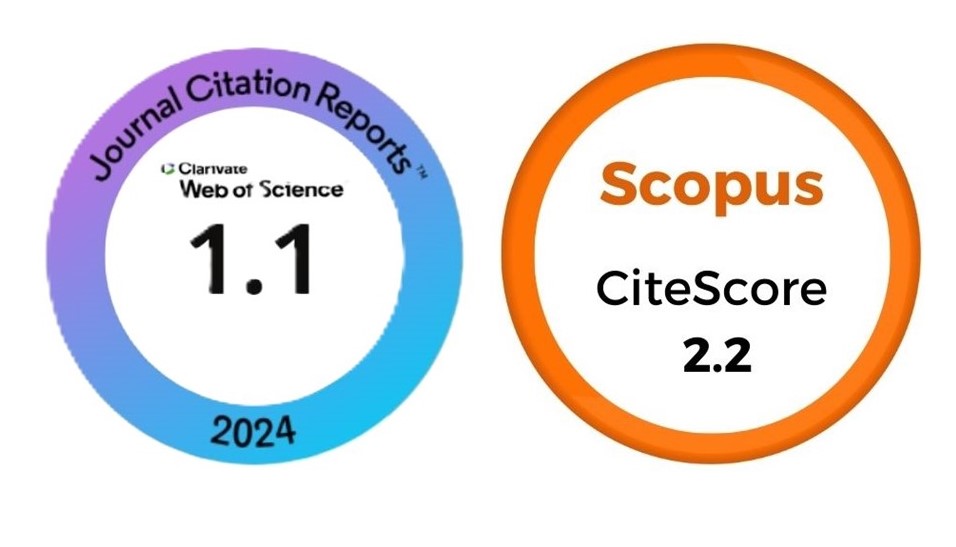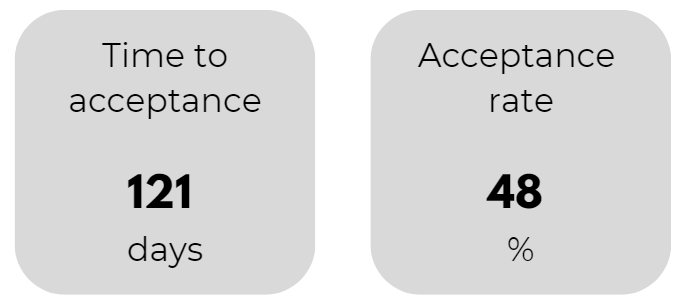Efeitos da irradiação de luz UV-C em duas cultivares de rosas infectadas com Botrytis cinerea
DOI:
https://doi.org/10.1590/2447-536X.v31.e252761Palavras-chave:
epiderme, mofo cinzento, estrela polar, pós-colheitaResumo
O mofo cinzento (Botrytis cinerea Pers.: Fr) é uma das doenças mais importantes que causam grandes perdas econômicas em rosas de corte. Os fungicidas químicos são amplamente utilizados para o manejo da enfermidade. No entanto, estes produtos apresentam grande acúmulo de resíduos e selecionam estirpes resistentes do patógenos aos defensivos. Neste contexto, a irradiação de plantas com luz UV-C (254 nm) tem se mostrado um tratamento eficaz para o controle de diversos fitopatógenos. Neste estudo, avaliou-se o efeito in vitro de três doses de luz UV-C (1,0, 1,5 e 2,0 kJ m-2) na germinação de conídios e no crescimento micelial de B. cinerea. Além disso, foram realizados ensaios in vivo em duas cultivares de rosa branca “Polar Star” e “Proud”. Para isso, os caules das rosas foram irradiados com luz UV-C antes da inoculação de B. cinerea ou inoculados diretamente com conídios irradiados. Os experimentos in vitro mostraram inibição de mais de 90% da germinação de conídios e a inibição total do crescimento micelial, em qualquer uma das doses avaliadas Além disso, a infecção dos botões de rosa foi significativamente reduzida ou evitada quando estes foram inoculados com conídios irradiados. Quando as rosas foram irradiadas com as mesmas doses e inoculadas com conídios viáveis, os sintomas apareceram mais rapidamente e as diferenças entre as variedades foram mais evidentes. A análise histológica das pétalas de rosa mostrou que as pétalas das rosas cv. Proud possuíam epiderme abaxial e adaxial mais espessa, com numerosas papilas alongadas em formato de cone, o que pode conferir maior tolerância a infecções por Botrytis.
Downloads
Referências
ABBEY, J.A.; PERCIVAL, D.; ABBEY, L.; ASIEDU, S. K.; PRITHIVIRAJ, B.; SCHILDER, A. Biofungicides as alternative to synthetic fungicide control of grey mould (Botrytis cinerea) – prospects and challenges, Biocontrol Science and Technology, v.29, n.3, p.207-228, 2019. https://doi.org/10.1080/09583157.2018.1548574
BARNETT, H. L.; HUNTER, B. B. Illustrated genera of imperfect fungi. Minesota, USA: American Phytopathological Society, 1998. 218 p.
BAUTISTA-SILVA, J.P.; BARBOSA-BARBOSA, H.J.; URIBE-VÉLEZ, D. Formulation prototype based on Rhodotorula mucilaginosa for the control of Botrytis cinerea in roses. Revista Colombiana de Biotecnología, v.18, n.2, p.13-23, 2016. https://doi.org/10.15446/rev.colomb.biote.v18n2.55826
BERGOUGNOUX, V.; CAISSARD, J.C.; JULLIEN, F.; MAGNARD, J.L.; SCALLIET, G.; COCK, J.M.; BAUDINO, S. Both the adaxial and abaxial epidermal layers of the rose petal emit volatile scent compounds. Planta, v.226, n.4, p.853-866, 2007. https://doi.org/10.1007/s00425-007-0531-1
BIKA, R.; BAYSAL-GUREL, F.; JENNINGS, C. Botrytis cinerea management in ornamental production: a continuous battle. Canadian Journal of Plant Pathology, v.43, n.3, p.345-365, 2021. https://doi.org/1 0.1080/07060661.2020.1807409
BYEONG-MING, S.; GUN-HEE, L.; HEE-JEONG, H.; JU.HEE, Y.; EUN-GYEONG, L.; HYUNJI, G.; HA-KYEONG, P.; KYUNGA, R.; JINWOO, K.; SANG-MIN, K.; DONGSEOB, T. Ultraviolet-C light at 222 nm has a high disinfecting spectrum in environments contaminated by infectious pathogens, including SARS-CoV-2. PLoS One, v.18, n11, e0294427, 2023. https://doi.org/10.1371/journal.pone.0294427
CARISSE, O.; VAN DER HEYDEN, H. Relationship of airborne Botrytis cinerea conidium concentration to tomato flower and stem infections. Plant Disease, v.99, n.1, p.137-142, 2015. https://doi.org/10.1094/PDIS-05-14-0490-RE
CHEUNG, N.; TIAN, L.; LIU, X.; LI, X. The destructive fungal pathogen Botrytis cinerea—Insights from genes studied with mutant analysis. Pathogens, v.9, n.11, p.923, 2020. https://doi.org/10.3390/pathogens9110923
CUN, SL; ZHANG, C.; CHEN, J.; QUIAN, L.; SUNA, H.; SONG, B. Effects of UV-B radiation on pollen germination and tube growth: A global meta-analysis. Science of the Total Environment, v.915, 170097, 2024. https://doi.org/10.1016/j.scitotenv.2024.170097
DARRAS, A.I.; DEMOPOULOS, V.; TINIAKOU, C. UV-C irradiation induces defense responses and improves vase-life of cut gerbera flowers. Postharvest Biology and Technology, v.64, n.1, p.168–174, 2012. https://doi.org/10.1016/j.postharvbio.2011.07.008
ELAD, Y.; PERTOT, I.; PRADO, A.M.C.; STEWART, A. Plant Hosts of Botrytis spp. In: FILLINGER, S.; ELAD, Y. (eds) Botrytis–the fungus, the pathogen and its management in agricultural systems. New York: Springer International Publishing, 2016. p.413-486.
FERNÁNDEZ-ORTUÑO, D.; PÉREZ-GARCÍA, A.; CHAMORRO, M.; DE LA PEÑA, E.; DE VICENTE, A.; TORÉS, J. A. Resistance to the SDHI fungicides boscalid, fluopyram, fluxapyroxad, and penthiopyrad in Botrytis cinerea from commercial strawberry fields in Spain. Plant Disease, v.101, n.7, p.1306-1313, 2017. https://doi.org/10.1094/PDIS-01-17-0067-RE
DEWEY, F.M.; GRANT-DOWNTON, R. Botrytis-Biology, Detection and Quantification. p.17-34. In: Botrytis – the Fungus, the Pathogen and its Management in Agricultural Systems. Fillinger, S., Elad, Y. (eds). 2016. Springer, Cham. https://doi.org/10.1007/978-3-319-23371-0_2
FILLINGER, S.; WALKER, A.S. Chemical control and resistance management of Botrytis diseases. In: FILLINGER, S.; ELAD, Y. (eds). Botrytis – the fungus, the pathogen and its management in agricultural systems. New York: Spinger, 2016. p.189-216.
FRAC. Recommendations for Fungicide Resistance Management from FRAC Working Group. Available. at: https://www.frac.info/fungicide-resistance-management/by-frac-working-group-expert-forum. Accessed on May 06th 2024.
JANISIEWICZ, W.J.; TAKEDA, F.; GLENN, D.M.; CAMP, M.J.; JURICK, W.M. Dark period following UV-C treatment enhances killing of Botrytis cinerea conidia and controls gray mold of strawberries. Phytopathology, v.106, n.4, p.386-394, 2016. https://doi.org/10.1094/PHYTO-09-15-0240-R
LARIOS-PALACIOS, O.E.; LÓPEZ-VAZQUEZ. E.Y.; CURIEL-RODRIGUEZ, A.; RUIZ-ESPINOZA, F.J.; SOLANO-VIDAL, R.; SERRATO-CRUZ, M.A. In vitro evaluation of methods against Botrytis cinerea. Revista Mexicana Ciencias Agrícolas, v.11. n.3. 2020. https://doi.org/10.29312/remexca.v11i3.2077
LEDERMANN, L.; DAOUDA, S.; GOUTTESOULARD, C.; AARROUF, J.; URBAN, L. Flashes of UV-C light stimulate defenses of Vitis vinifera L. ´Chardonnay´ against Erysiphe necator in greenhouse and vineyard conditions. Plant Disease, v.105, p.2106-2113, 2021. https://doi.org.10.1093/PDIS-10-20-2229-RE
MACNISH, A.J.; MORRIS, K.L.; THEIJE, A.; MENSINK, M.G.J.; BOERRIGTER, H.A.M.; REID, M.S.; JIANG, C.Z.; WOLTERING, E.J. Sodium hypochlorite: A promising agent for reducing Botrytis cinerea infection on rose flowers. Postharvest Biology and Technology, v.58, n.3, p.262–267. 2010. https://doi.org/10.1016/j.postharvbio.2010.07.014
MARTÍNEZ-HERNÁNDEZ, G.B.; BLANCO, V.; BLAYA-ROS, P. J.; TORRES-SÁNCHEZ, R.; DOMINGO, R.; ARTÉS-HERNÁNDEZ, F. Effects of UV–C on bioactive compounds and quality changes during shelf life of sweet cherry grown under conventional or regulated deficit irrigation. Scientia Horticulture, v.269, n.1, p.109398, 2020. https://doi.org/10.1016/j.scienta.2020.109398
MARTÍNEZ-SÁNCHEZ, A.; GUIRAO-MARTÍNEZ, J.; ANTONIO-MARTÍNEZ, J.; LOZANO-PASTOR, P.; AGUAYO, E. Inducing fungal resistance of spinach treated with preharvest hormetic doses of UV-C. LWT, v.113, n.1, p.108302, 2019. https://doi.org/10.1016/j. lwt.2019.108302
MUÑOZ, M.; FAUST, J.E.; SCHNABEL, G. Characterization of Botrytis cinerea from commercial cut flower roses. Plant Disease, v.103, n.7, p.1577-1583, 2019. https://doi.org/10.1094/PDIS-09-18-1623-RE
PALMER, J.M.; WIEMANN, P.; GRECO, C.; CHIANG, Y.M.; WANG, C.C.C.; LINDNER, D.L.; KELLER, N.P. The sexual spore pigment asperthecin is required for normal ascospore production and protection from UV light in Aspergillus nidulans. Journal Industrial Microbiology and Biotechnology, v.48, n.9-10, 2021. https://doi.org/10.1093/jimb/kuab055
PÉREZ, D.; GARCÍA-GODOS, P. Identificación del agente causal del marchitamiento en Caesalpinia spinosa tara y el efecto antagónico de aislados de Bacillus spp. y Trichoderma sp. Ecología Aplicada, v.18, n.1, p.51-57, 2019. http://dx.doi.org/10.21704/rea.v18i1.1306
PHONYIAM, O.; OHARA, H.; KONDO, S.; NARADISORN, M.; SETHA, S. Postharvest UV-C irradiation influenced cellular structure, jasmonic acid accumulation, and resistance against green mold decay in Satsuma mandarin fruit (Citrus unshiu). Frontiers in Sustainable Food Systems, v.5, n.1, p. 684434, 2021. https://doi.org/10.3389/fsufs.2021.684434
RAMALINGAM, S.; LE MYINT, Z.; AHN, S. Y.; RYU, J. A.; LEE, S. M.; YUN, H. K. UV-C treatment elicits resistant responses against Botrytis cinerea infection and the improvement of fruit characteristics in grapevines. Horticulture, Environment, and Biotechnology, p.1-18, 2024. https://doi.org/10.1007/s13580-024-00602-w
SHAO, W.; YOUFU Z.; ZHONGHUA, M. Advances in understanding fungicide resistance in Botrytis cinerea in China. Phytopathology, v.111, n.3, p.455-463, 2021. https://doi.org/10.1094/PHYTO-07-20-0313-IA
SOFIANOS, G.; SAMARAS, A.; KARAOGLANIDIS, G. Multiple and multidrug resistance in Botrytis cinerea: molecular mechanisms of MLR/MDR strains in Greece and effects of co-existence of different resistance mechanisms on fungicide sensitivity. Frontiers in Plant Science, v.14. 2023. https://doi.org/10.3389/fpls.2023.1273193
SONNTAG, F.; LIU, H.; NEUGART, S. Nutritional and physiological effects of postharvest UV radiation on vegetables: A Review. Journal of Agricultural and Food Chemistry, v.71, n.26, p.9951-9972, 2023. https://doi.org/10.1021/acs.jafc.3c00481
STEINER, U.; OERKE, E.C. A melanin-deficient isolate of Venturia inaequalis reveals various roles of melanin in pathogen life cycle and fitness. Journal of Fungi, v.9, n.1, p.35, 2022. https://doi.org/10.3390/jof9010035
TERAO, D.; NECHET, K.L.; FRIGHETTO, R.T.; ANJOS, V.D.; MAIA, A.H.; HALFELD-VIEIRA, B.A. Control of Fusarium rot in Galia melon and preservation of fruit quality with UV-C radiation and hot water treatments. Tropical Plant Pathology, v.46, n.3, p.350-359, 2021. https://doi.org/10.1007/s40858-021-00432-6
THI HA, S.T.; CHOI, B.; IN, B. Nature and Regulation of Botrytis cinerea in Rosa hybrid. Flower Research Journal, v.29, n.3, p.129-137, 2021. https://doi.org/10.11623/frj.2021.29.3.02
URBAN, L.; CHARLES, F.; ALCÁNTARA DE MIRANDA, M.R.A.; AARROUF, J. Understanding the physiological effects of UV-C light and exploiting its agronomic potential before and after harvest. Plant Physiology and Biochemistry, v.105, n.1, p.1-11, 2016. https://doi.org/10.1016/j.plaphy.2016.04.004
VANHAELEWYN, L.; VAN DER STRAETEN, D., DE CONINCK, B.; VANDENBUSSCHE, F. Ultraviolet Radiation from a plant perspective: The plant-microorganism context. Frontiers in Plant Science, v.11, p.597642, 2020. https://doi.org/10.3389/fpls.2020.597642
VEGA, K.; OCHOA, S.; PATIÑO, L.F.; HERRERA-RAMÍREZ, J.A.; GÓMEZ, J.A.; QUIJANO, J.C. UV-C radiation for control of gray mold disease in postharvest cut roses. Journal of Plant Protection Research, v.60, n.4, p.351–361, 2020. https://doi.org/10.24425/jppr.2020.133957
ZHONG, S.; ZHANG, J.; ZHANG, G.Z. Botrytis polyphyllae: A New Botrytis Species Causing Gray Mold on Paris polyphylla. Plant Disease, v.103, n.7, p.1721-1727, 2019. https://doi.org/10.1094/PDIS-07-18-1284-RE
ZURAW, B.; SULBORSKA, A.; STAWIARZ, E.; WERYSZKO, C.E. Flowering biology and pollen production of four species of the genus Rosa L. Acta Agrobotanica, v.68, n.3, p.267-278, 2015. https://doi.org/10.5586/aa.2015.031
Downloads
Publicado
Edição
Seção
Licença
Copyright (c) 2025 Ornamental Horticulture

Este trabalho está licenciado sob uma licença Creative Commons Attribution 4.0 International License.








